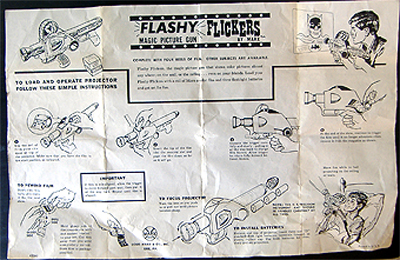
Mighty Mouse 3-D Comics
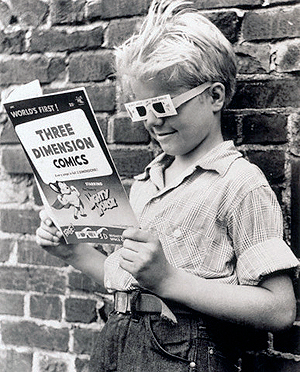 |
 |
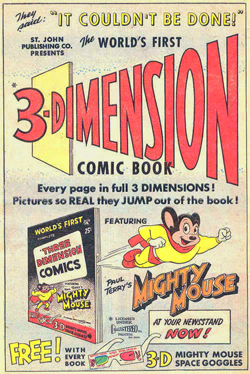 |
It was the "World's First" Three-Dimension Comics featuring Mighty Mouse published by St. John in September, 1953.
St. John Publications notable comics include the "World's First" 3-D Comic Book, Three Dimension Comics #1 (Sept. 1953 oversize format, Oct. 1953 standard-size reprint), featuring the
Terrytoons movie-cartoon character Mighty Mouse. According to Joe Kubert, co-creator with the brothers Norman Maurer and Leonard Maurer,
it sold an exceptional 1.2 million copies at 25 cents apiece at a time when comics cost a dime. [1]. St. John also published the second 3-D comic,
the aptly named 3-D Comics, the single issue of which incongruously billed itself as "World's First!"  Click her to learn more about 3-D ANAGLYPHS |
|
-Top-


 |
A Very Short
Story of Tru-Vue Cards
After Sawyer's
(View-Master) purchased the Tru-Vue Company (3D filmstrip makers) of Rock
Island, IL, they were moved to the View-Master Beaverton, Oregon
plant. After little more than a year, the filmstrip products was
discontinued as being too duplicative and competitive with View-Master
reels. |  |
But soon, thereafter, a
new product was developed for a "lower-end" market, using the same Tru-Vue
name, but a completely different 3D product, not using the expensive
Kodachrome film as used in View-Master reels, but a much less expensive
film which soon began to lose its color and take on a magenta
hue.
This new format was a card with 7 stereo image pairs
vertically aligned on a card (see the creation of this product in
INSIDE 3D Magazine Vol.II no.4). Even after the sale of Sawyer's
View-Master to GAF, the Tru-Vue Card products continued to be produced for
several more years, before finally being discontinued.
In spite of
their unfortunate loss of color, Tru-Vue Cards are still highly
collectible, because many titles, topics, and views that appeared on
Tru-Vue Cards never appeared on View-Master reels, or anything else 3D.
For these very special views, it's "the only show in town".
|
|
-Click the follow the links below to view Our Vintage Viewers- |
|
|
|
|
Collecting Vintage Viewers/Slides
Stereo (3-D) images come in many formats, vintage stereo card views, modern day View-Master images, Tru-Vue, Novel-View, anaglyph comic books, lenticular images, holograms, etc. All of these can provide true 3-D viewing and be of interest to the collector/photographer. Stereoscopic, or 3D photography, is a popular medium because it is able to recreate the illusion of depth.
|
|
|
Stereo views or stereo cards can be divided into three basic categories – flat mounts, curved mounts and lithographs. Flat and curved mount images are mounted onto cardboard like mat at the correct angle to provide a 3-D effect -- the left and right images differing slightly. Flat mount cards have little if any curving to the card.
|

Example of a Flat Mount Card |
| Curve mounts (mass produced by Keystone, Underwood, Griffith & Griffith, Kilburn and others) have a definite curvature built into the card. Both of these kinds of views use "real photographs" meaning there are two actual pictures mounted on the card.
|
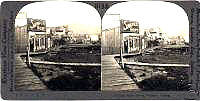
Example of a Curved Mount Card |
The third kind of card, a lithograph, is a flatter, thinner card (more like paper than cardboard) and the image is printed onto the card via a lithograph process. These images are usually in color. However, a color stereo view may also be a hand tinted curved mount view so not all color views are lithos.
|

Example of a Lithograh View |
Subject matter varies widely. Companies like Keystone, Underwood, and Whiting produced boxed sets of views. These contained anywhere from 50-400 views covering a certain subject. Keystone View Company contained their tradition of making stereo cards until the early 1950’s.
|
| Collectors look for what interests them most, however, one standard is in effect for everything stereo –condition!A damaged view – whether it is water damage, a crack in the card, etc. diminishes the value of the image. Certain subjects are considered hard to find American Indians, Western United States street scenes, Civil War, famous people, special events, small town America, etc.
|
| Collectors look for what interests them most, however, one standard is in effect for everything stereo –condition!A damaged view – whether it is water damage, a crack in the card, etc. diminishes the value of the image. Certain subjects are considered hard to find American Indians, Western United States street scenes, Civil War, famous people, special events, small town America, etc.
Of equal importance is stereo viewing equipment. Many different types of were made. Brewster created a boxlike hand held viewer that was available in a variety of woods Oliver Wendell Holmes created the Holmes stereoscope. His invention brought stereo viewing to the masses because the viewer was considerably less expensive than the Brewster style viewers.
|
| TRU-VIEW Established in 1931-32. By the summer of 1933, in time for the nearby Chicago "Century of Progress Exposition", the new company was producing and marketing stereo filmstrips and viewers.
|
 |
Tru-Vue was able to re-inspire enough public interest in stereo views with this new, "modern" format to become the first stereo filmstrip to achieve commercial success and mass distribution. The number of titles available at any one time was probably around 400. By 1949, sales had reached about 1 ½ million filmstrips a year. including the hundreds of promotional and instructional films Tru-Vue made to-order for industrial and educational uses.
In 1938 Sawyer's Inc. introduced the View-Master stereoscope and its convenient, full-color stereo reels. Competition with Tru-Vue, however was slow to develop but by 1949 the competition from View-Master was being felt. In order to get in on the Disney Cartoon contract and to keep the Tru-Vue out of bigger corporate hands, Sawyer's purchased Tru-Vue and all its physical assets in 1951.
|
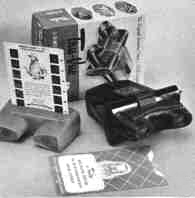 |
From the beginning, Tru-Vue was considered a toy and sold in toy stores while View-Master products were sold in photo departments and souvenir shops. Tru-Vue cards featured subjects like Robin Hood, Disney characters, with a limited selection of scenic titles. When GAF purchased View-Master they dropped the Tru-Vue line as they continued to move View-Master itself into the children’s market and toy store shelves.
|
| VIEW-MASTER William Gruber, a piano tuner who had emigrated from Munich, Germany to Portland, Oregon, developed the first prototype View-Master viewer in 1938. The first production design was called the Model "A" viewer. This model was round and hinged at the bottom; opening somewhat like a clamshell.
|
| View-Master was made available to the public in October 1939. Viewers sold with 15 scenic reels on blue stock with gold labels, with subjects like Crater Lake, Grand Canyon and Glacier National Park. The big launch was at the 1939 New York World’s Fair and the 1940 San Francisco International Expo. 2nd generation reels were tan with a blue ring around the images. Model "A" viewers were constructed of Kodak "tenite". Most of these viewers are warped in various degrees when found today.
|
| Production slowed down with the onset of World War II. Film and paper were in short supply. A new model "B" viewer made of Bakelite was developed during this time. It also had the round clamshell like design but was sturdier and would not warp. Available in three colors it was widely distributed in mostly black.
|
| Post war times were much better. More reel titles were developed and sales were phenomenal. In 1946 a Model "C" bakelite viewer was developed which became the standard for every model produced since then. With this viewer the reel was inserted directly into the top of the viewer as opposed to having the viewer open up for reel insertion.
|

Model C Bakelite Viewer |
Advancements in plastics brought new viewers changing from Bakelite to plastic in 1959. Colors changed, reel levers were updated to prevent marking the reel with viewer rings, etc.
|
| Along with changes in viewers came the addition of new reel titles. In 1966, when GAF Corporation purchased View-Master, the field of subjects increased dramatically. Emphasis shifted a bit from strictly scenic titles to TV themed three-reel packets.
|
| TV shows such as Lost in Space, The Munsters and The Addams Family are popular collectible View-Master packets today. Many scenic titles are also popular among collectors especially Disneyland and other theme park titles
|
| In 1989 the product was purchased by Tyco Toys and became a part of their standard toy line. By this time, the product was basically all children’s subjects. Character viewers were introduced during the Tyco years – Mickey Mouse, Big Bird, Casper, etc.
|
| View-Master is owned today by Mattel and marketed by their Fisher-Price division. Production of View-Master products moved to Mexico in the year 2000 where Mattel has a large plant.
|
| Collecting View-Master is a lot like collecting stereo views – condition being a key factor. Since there is a wealth of titles everyone picks their own niche when it comes to acquiring View-Master items.
|
| Some items are very common – i.e. the Model C viewer – and are easy to come by whereas others, i.e. Model D focusing viewer, is much scarcer. If you wish to collect all of them, look for clean, working examples with little or no discoloration. Almost all Model A’s are warped so you need to find out to what extent. Also, color variations exist for many viewers as well – making some of them rarer than others.
|
| Below is an example of a focusing viewer. This feature has a focusing dial over the right lens that moves the lenses back and forth to focus for individual viewing.
|
 |
Packets consist of three reels and an outer color envelope. Some had little descriptive booklets accompany the reels and you should be sure that the booklet is included. Reels that have bubbling may or may not suit you – as long as the bubbling does not interfere with the images it does not bother me but it does bother some other collectors.
|
| Get to know the era of the packet. Early reels were sold as singles. Many of these singles were later re-packaged as three reel sets. Early Sawyers sets were marked in envelopes known as "line drawn" (S1 or S2 packets) the next generation called "pastel border" or "picture window" styles (S3 or S4). The third generation of Sawyers packets were made with a "full face" cover -- with the picture covering the "full face" of the packet (S5). Then they came out with the oval Sawyers logo on the cover (S6).
|
| GAF packets were issued in several different generations as well. These consist of: (G1) GAF logo at bottom of packet, (G2) small gaf logo at top of packet, (G3) large GAF logo at top of packet.
|
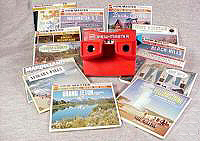 |
When View-Master International took over the company from GAF they issued mainly blister packs but some older style packets were made with the GAF logo basically removed.
|
| Reels and viewers were manufactured by both the Portland and Belgium plants. A handful of items were made in Australia, France, England and India as well. The later items being extremely difficult to obtain.
|
| View-Master has its own listing on ebay and there are hundreds of items for sale at any given time. Most reels are scanned images and, if you wish to sell View-Master on ebay, I recommend scanning at 72 dpi. This gives a nice, clear image and uploads easy for most folks. Describe any and all faults in your listing. Better to have folks know exactly what they are buying rather than have problems on either end at the close of the auction. Most reels can be shipped safely in a padded envelope. Projectors and the like weigh more and cost considerably more to send so make sure this is noted in any auction. Viewers weigh about 2 ½ lbs when properly packaged. The older bakelite models sometimes weigh a bit more. This should give you some idea for shipping costs.
|
| Our Vintage Viewers/Films |
-Top-
| Strip Viewers |
 | This TRU-VUE movie viewer comes with 13 individul films. The viewer was manufactured by Tru-vue Inc of Rock Island Illinois and comes with an insrtuction card and a flyer telling about the "new sensation that awaits you". From the looks of the flyer the viewer was purchased in Colorado Springs Colorado. Films for the viewer were 35 cents and the viewer was 65 cents. What a bargin. It is in it's original box. |
Tru-Vue Filmstrips - from 1933-1951:
A brief history of the Tru-Vue Company
The Tru-Vue Company of Rock Island, IL debuted their product at the 1933 Century of Progess World's Fair in Chicago, 6 years and a World's Fair earlier than the View-Master® debut. Although the 3D Stereo Filmstrip format was not brand new, (see Novelview, here at the 3Dstereo eMarket) their marketing and choice of titles made them a smashing success, bringing sepiatone 3D Stereo Filmstrips into the homes across America. The original views were initially made with a 5"x7" Stereo Graflex camera and mounted as black and white prints, then copied onto 35mm transparancy film. Each filmstrip usually contains 14 stereo pairs.
Some 17 years later, after competing for 11 years against the color 3D Stereo reels of View-Master®, Tru-Vue tried their hand at color too, but was soon purchased by their competitor, View-Master, who needed the lucrative Disney licenses that Tru-Vue had obtained.
For about a year, View-Master produced in Portland, Tru-Vue Filmstrips in both color and black & white film (mostly Disney subjects) and then dicontinued the product after an 18 year run.
Tru-Vue 3D stereo cards and 2D cards were not made by the Tru-Vue Company, but were a View-Master bargain-priced product, utilizing the Tru-Vue name which they owned after purchasing Tru-Vue.
Today, Tru-Vue 3D Stereo Filmstrips, are collected and viewed by a smaller, but extremely active group of collectors, who regard Tru-Vue's coverage of World's Fairs, Hollywood, Night Clubs, Fashion and Risque as unparralled in the area of 3D Stereo.
|
|
 |
WOW!!! As a Prince Valiant collector I know unique collectible items come along very infrequently! This is such a case. The image above shows part of a vintage 3-D Prince Valiant Film Strip from 1949. The partial picture of the original filmstrip above does not give it justice. It is in excellent condition and it was produced using Hal Foster's art.
It is amazing to be able to see Val come to life in crisp, clear 3-D.
This filmstrip tells a story along with the pictures as you advance it frame by frame using the Tru-Vue's red lever.
Displayed below is a Tru-Vue Viewer by it's original box, and the Prince Valiant filmstrip, in it's original box. |
   |
Tru-Vue 3-D Film Strips

|
These strips are made on 35 mm film. Each image is about 19 mm by 20 mm (excluding captions) and images are on 63.5 mm centers. There are usually 14 pairs, and the order of images on a strip is 1R, title, 2R, 1L, 3R, 2L, 4R, 3L, 5R, 4L, etc. |
WANTED FILM STRIPS (if you can find them, please let me know)
COLOR
C-154 Prince
Valiant 10 View (Full Frame) Film
2166 Prince Valiant 15 View (Full
Frame) Film
C-161 Red Ryder (Western) 10 View (Full Frame) Film
C-161 Red Ryder 14 View (Half Frame) Film
C-111 Captain Marvel 14
View (Half Frame) Film
B/W
245 Red Ryder Miscellaneous
-click here- to view 245 Red Ryder 245
247
Captain Marvel Verses Steam Roller Miscellaneous
248 Flash Gordon
Miscellaneous
234 Prince Valiant 10 frame version
Manfred Schmidt Collectible
Cameras
773-631-5949
karla60631@aol.com.
Manfred Schmidt
6552 N. Oak Park Ave.
Chicago, IL 60631
craigcamera.com
|
|
-Top-
| Tru-Vue Card Viewers |
 |
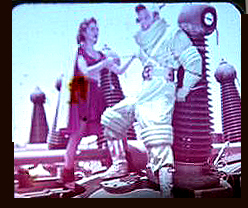
The red lever advanced each scene forward.
Viewer is in very good condition.
|
 |
Tru-Vue card
Mask of
the Lone Ranger T-12
Dated 1955
Card in original sleeve.
Single 7
image Tru-Vue Card. Live action scenes from the 1955 TV show featuring the
most famous masked man, Tonto, and Hi Yo Silver, and the first of hundreds
of productions to use classical music in their sound score. Unsold old
store stock in original sleeve. |
 |
Tru-Vue card
Mask of
the Lone Ranger T-12
Dated 1955
Card in original sleeve.
Single 7
image Tru-Vue Card. Live action scenes from the 1955 TV show featuring the
most famous masked man, Tonto, and Hi Yo Silver, and the first of hundreds
of productions to use classical music in their sound score. Unsold old
store stock in original sleeve. |
 |
Tru-Vue card
Mask of
the Lone Ranger T-12
Dated 1955
Card in original sleeve.
Single 7
image Tru-Vue Card. Live action scenes from the 1955 TV show featuring the
most famous masked man, Tonto, and Hi Yo Silver, and the first of hundreds
of productions to use classical music in their sound score. Unsold old
store stock in original sleeve. |
 |
Tru-Vue card
Mask of
the Lone Ranger T-12
Dated 1955
Card in original sleeve.
Single 7
image Tru-Vue Card. Live action scenes from the 1955 TV show featuring the
most famous masked man, Tonto, and Hi Yo Silver, and the first of hundreds
of productions to use classical music in their sound score. Unsold old
store stock in original sleeve. |
 |
Tru-Vue card
Mask of
the Lone Ranger T-12
Dated 1955
Card in original sleeve.
Single 7
image Tru-Vue Card. Live action scenes from the 1955 TV show featuring the
most famous masked man, Tonto, and Hi Yo Silver, and the first of hundreds
of productions to use classical music in their sound score. Unsold old
store stock in original sleeve. |
 |
Tru-Vue card
Mask of
the Lone Ranger T-12
Dated 1955
Card in original sleeve.
Single 7
image Tru-Vue Card. Live action scenes from the 1955 TV show featuring the
most famous masked man, Tonto, and Hi Yo Silver, and the first of hundreds
of productions to use classical music in their sound score. Unsold old
store stock in original sleeve. |
 |
Tru-Vue card
Mask of
the Lone Ranger T-12
Dated 1955
Card in original sleeve.
Single 7
image Tru-Vue Card. Live action scenes from the 1955 TV show featuring the
most famous masked man, Tonto, and Hi Yo Silver, and the first of hundreds
of productions to use classical music in their sound score. Unsold old
store stock in original sleeve. |
 |
Tru-Vue card
Mask of
the Lone Ranger T-12
Dated 1955
Card in original sleeve.
Single 7
image Tru-Vue Card. Live action scenes from the 1955 TV show featuring the
most famous masked man, Tonto, and Hi Yo Silver, and the first of hundreds
of productions to use classical music in their sound score. Unsold old
store stock in original sleeve. |
 |
Tru-Vue card
Mask of
the Lone Ranger T-12
Dated 1955
Card in original sleeve.
Single 7
image Tru-Vue Card. Live action scenes from the 1955 TV show featuring the
most famous masked man, Tonto, and Hi Yo Silver, and the first of hundreds
of productions to use classical music in their sound score. Unsold old
store stock in original sleeve. |
 |
Tru-Vue card
Mask of
the Lone Ranger T-12
Dated 1955
Card in original sleeve.
Single 7
image Tru-Vue Card. Live action scenes from the 1955 TV show featuring the
most famous masked man, Tonto, and Hi Yo Silver, and the first of hundreds
of productions to use classical music in their sound score. Unsold old
store stock in original sleeve. |
 |
Tru-Vue card
Mask of
the Lone Ranger T-12
Dated 1955
Card in original sleeve.
Single 7
image Tru-Vue Card. Live action scenes from the 1955 TV show featuring the
most famous masked man, Tonto, and Hi Yo Silver, and the first of hundreds
of productions to use classical music in their sound score. Unsold old
store stock in original sleeve. |
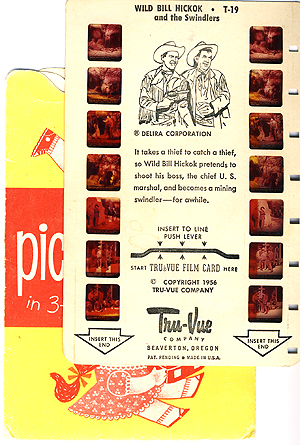 |
Tru-Vue card
Mask of
the Lone Ranger T-12
Dated 1955
Card in original sleeve.
Single 7
image Tru-Vue Card. Live action scenes from the 1955 TV show featuring the
most famous masked man, Tonto, and Hi Yo Silver, and the first of hundreds
of productions to use classical music in their sound score. Unsold old
store stock in original sleeve. |
|
|
-Top-
| View-Master Circular Card Viewers |
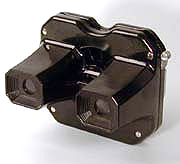 |
From the start of production in
1939 View-Master, until recently, named their viewer models in
chronological letter order, starting with Model A through Model N. Viewers
made in the Belgian View-Master plant had a Model Number as well as a
Model Letter.
Except for reels made in last few years that have a colorful sticker on
the back of the reel, covering the center hole, which prevents use of
these new reels in Model A & Model B viewers, all reels fit all
viewers.
|
 |
Mighty Mouse B 526
1958
Booklet is included.
3 reel packet
Original sleeve and
illustrated booklet
Excellent condition.
It comes with a plastic
sleeve protector.
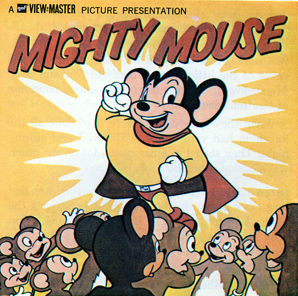 |
-Top-
|
 |
Buck Rogers - Battle
on the Moon 1978
3 reel packet Number J1
Reels 002-153, 002-155, 002-156
25th century Buck Rogers in a space adventure in 3D entitled "Battle on
the Moon".
Booklet is included.
Mint.

|
-Top-
|
 |
Godzilla -
Godzilla's Rampage 3 reel packet J23
Reels 002-143, 002-144, 002-145
A prehistoric monster spreads destruction through Seattle and the story
is told through 3D cartoon drawings. Non-Kodachrome reels are like
new.
Booklet is included.

|
-Top-
|
 |
The Lone Ranger -
Mystery Rustler 1956
Reels 962-A, 962-B, 962-C

|
-Top-
|
 |
Rin Tin Tin -
Rin Tin Tin In Vanishing Guns #930-A
Rin Tin Tin In Indian Ambush #930-B
Rin Tin Tin In High Danger #930-C
|
-Top-
|
 |
Rare Cisco Kid & Pancho
1950 View-Master Reel# 960
Cisco and pancho battle rustlers.The Cisco Kid was a film, radio, television and comic book series based on the fictional Western character created by O. Henry in his short story "The Caballero's Way," published in 1907 in the collection Heart of the West. Films and television depicted the Cisco Kid as a heroic Mexican caballero, although in O. Henry's original story, he was a non-Hispanic character and a cruel outlaw, probably modelled on Billy the Kid. Duncan Renaldo as the Cisco Kid

Click here to learn more about the Cisco Kid. |
-Top-
|
 |
Adventures of tarzan
1960 View-Master Reel# 975
 |
-Top-
|
 |
Peter Pan
1957 View-Master Packet# B 372
Reels B 3721, B 3722, B 3723
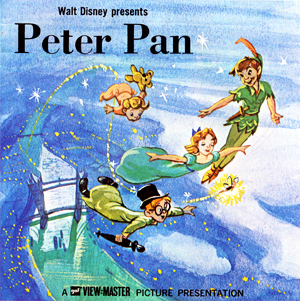 |
-Top-
|
 |
Roy Rogers
1956 View-Master Packet# 948
Reels 948-A, 948-B, 948-C
 |
-Top-
|
 |
Robin Hood
1954 View-Master Packet# B480
Reels:
972A Robin Hood Meets Friar Tuck
972B Little John joins the Merry Men
972C The Shooting Match. These stories are pictured with claymation type figures.
 |
-Top-
|
 |
Lassie Look Homeward
1965 View-Master Packet# ???
Reels:
 |
-Top-
|
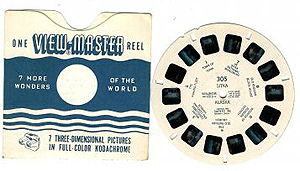 |
Sitka Alaska and Original Sleeve
1950 View-Master Packet# #305
Images:
- Town of Sitka
- The Fishing Street
- Mount Edgecumbe and Seaplane Harbor
- The Old Russian Church
- Interior of the Russian Church
- Old Russian Block House
- Sitka National Monument
|
|
|
-Top-
| View-Master Junior Projector |

 |
As the View-Master became a more popular household item across North America in the 1950s, Sawyer's View-Master released the Junior Projector. The Junior Projector's Bakelite and metal exterior could be produced inexpensively and made the projector light enough to be carried by a child. The Junior Projector was not just for children though - Sawyer's claimed that this invention was "ideal for home, classroom, and commercial use." Advertisements in Canadian newspapers showed the entire family enjoying View-Master images.
Similarly to the View-Master, reels could be inserted in the Junior Projector through a slot int he top of the projector. The image changed by pressing down a lever. Unlike the original View-Masters though, the images were projected onto a screen so that they could be enjoyed by more than one person; however, the stereo effect that created 3-dimensional images was lost.
Although this little beauty has the look of a slide projector, the View-Master Junior Projector was actually designed to project the pictures of View-Master reels onto a screen. Made from Bakelite and powdered grey metal. Therefore easy to produce and durable. Dates to 1950s. Projected images in 2D but allowed more than one person to look at the pictures. From box, lightness and carrying case, it was liekly made for children to use.
Sawyer’s View-Master Junior Projector in metal and Bakelite finish. It has been kept in wonderful condition in its original box for all of these years. The electrics, Bulb and wiring all work very well and appear to be original.
The box is a little beaten up but still holds together well.

|
|
 |
|
-Top-
| Acme Film Viewer |

 |
Vintage 1947 Acme Film Viewer
ACME Product of Acme Plastic Toys, Inc, New York, N.Y. Copyright 1940 |
|
|
-Top-
| MIGHTY MOUSE MOVIES Picture Viewer |
 |
MIGHTY MOUSE MOVIES Picture Viewer
1981 HECKLE & JECKLE |
|
|
-Top-
| View-Master Show Beam Projector |
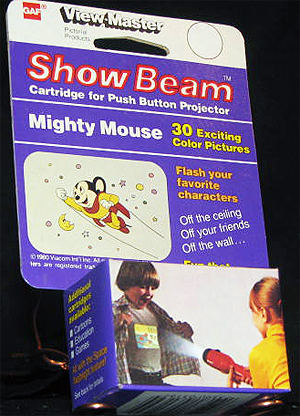 |
View-Master Show Beam Projector
This set includes 3 new in box Show Beam Reels, "I Can Learn By Myself:Numbers", "I Can Learn By Myself:Alphabet" and Mighty Mouse.
The packages of some of these reels are sun faded.
Used Reels
- Mickey Mouse X4
- Popeye X 2
- Spider-man X1

|
|
|
|



































































